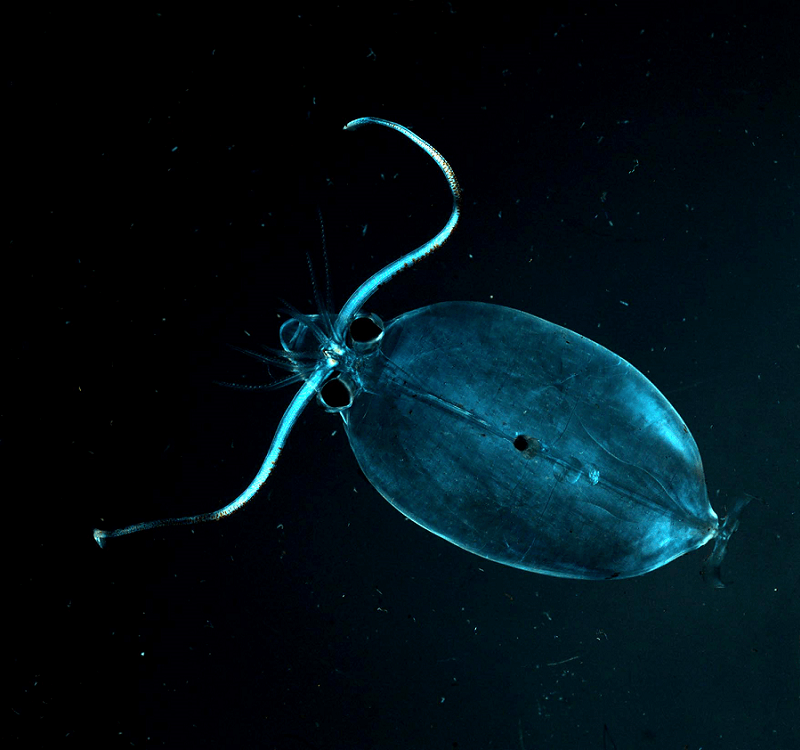
Glass Squid Facts
- The attention-grabbing term of Glass Squid serves as the most frequently used common name for any member of an entire Family. These creatures do have a few other general titles by which they’re known, though. These options include Cockatoo squids and Cranchiid squids.
- This remarkable collection of marine wonders stands out in the minds of many researchers for an interesting reason. That’s not only due to their extremely unique appearance, though. These amazing animals also merit note because cientists currently recognize 60 known members.
- Naturally, a great many different scientists acknowledged each individual species as separate and distinct at differing times. The German naturalist Johann Georg Christian Lehmann first named the Family, however. He achieved that scientifically noteworthy deed in the year 1822.
- Fortunately, all recognized types of Glass Squid seem to be maintaining population bases that remain both stable and sufficient. That pleasant state also seems to hold true throughout the entirety of their ranges. The IUCN does not currently show any of them on its Red List.
- These fascinating creations of Nature and evolution nevertheless still face numerous potential threats to their continued existence. In this regard, they face the same dangers as all forms of life on earth today. Most of these stem from the actions of man, including climate change.
Related Articles
Glass Squid Physical Description
The stunning grouping of marine marvels collectively known by the moniker Glass Squid never fail to capture the immediate attention of those who view them. Given the large current number of species within the group, though, each example understandably does so for slightly varying reasons.
This trend also holds true in regards to a basic natural pattern common among their many kindred across the globe. That’s the fact that each separate species displays a certain degree of the physiological characteristic of sexual dimorphism. That trait varies widely among members, though.
Every member of the Family represents a member of a highly diverse group of deep-sea squids with striking physical features. While their physical appearances do vary notably between species, several basic traits nonetheless still prevail, remaining present in all of them, thereby unifying them.
Every squid in this Family possesses a mantle, like all squids. This typically develops as elongated and tubular, though some species develop as more rounded. Sizes also differ significantly. The smallest have mantle lengths of only about 1.2 in (3 cm), while some reach a length of 9 ft (2.75 m)!
Unquestionably, the most notable attribute of each form of Glass Squid, though, obviously remains the transparent nature of the body. This allows for camouflage even in areas of open water. Intriguingly, organs such as the digestive gland and eyes often appear as the only visible structures.
These amazing animals also possess a total of eight arms and two long tentacles. Each of these appendages typically also has specialized suckers or hooks. Although many species within the grouping lack a functional ink sac, some of the members nevertheless retain a slightly reduced one.
The eyes evolved as large and forward-facing. Impressively, in some species, one eye develops as notably larger than the other. Every member also possesses several fins, located at the rear end of the mantle. These also vary, being small and oval, or large and ear-like, depending on the genus.
- Kingdom: Animalia
- Phylum: Mollusca
- Class: Cephalopoda
- Order: Oegopsida
- Family: Cranchiidae
Glass Squid Distribution, Habitat, and Ecology
Given the sheer number of species collected within the Family that bears the name Glass Squid, the members inhabit an extremely broad range of the marine regions of the globe. It therefore remains quite easy to understand the widely scattered locations where one finds these amazing animals.
They have a virtually global presence, appearing in tropical, temperate, and polar oceans. The Atlantic Ocean and Pacific Ocean each host many species within several genera. The Indian Ocean also contains several midwater species, while the Southern Ocean and Antarctic waters host a few.
Examples of these wonders also display very strong and clear preferences regarding their choice of habitat. All live in the open ocean, and not near the sea floor. Most reside at depths ranging from between 656 – 13,123 ft (200 – 4,000 m). Many migrate to higher points at night to feed.
Other conditions also play important factors in their choice of residence. They require low-light or near-dark conditions, to maximize their transparency. Most adapted long ago to the great pressures found at greater depths. Relative salinity levels also play an important role in their selections.
The majority of Glass Squid species feed primrily on small fish, crustaceans, and other cephalopods. Some, however, specialize in copepods and krill when young or small. Many use bioluminescence to attract their prey, attacking as ambush predators, using their tentacles or hooks to grab them.
Following another evolutionary pattern common among their kind, they reproduce only once in their lives. Females produce large, gelatinous egg masses, often in deeper waters. Hatchlings emerge as planktonic in nature, drifting with currents before migrating into adult midwater habitats.
Many of them also serve as key prey species for others. Some fish consume the smaller one’s or the hatchlings. Multiple marine mammals also consume them in numbers. Surface feeding seabirds form another predator when they rise to the surface. Larger squids also prey on them, as well.
Species Sharing Its Range
Check out our other articles on 8 South American Geological Marvels, Gocta Cataracts, Thorny Dragon, Bosnian Pine, Black Rain Frog, Snow Leopard, Hyacinth Macaw, Southern Stingray
